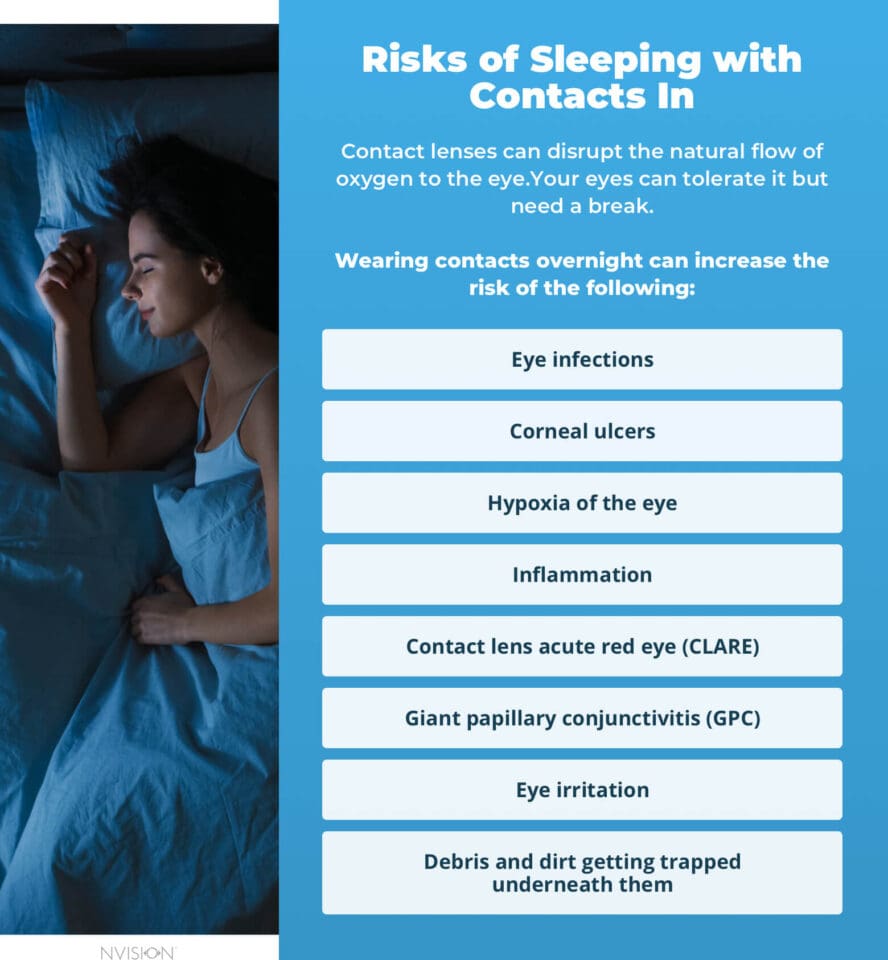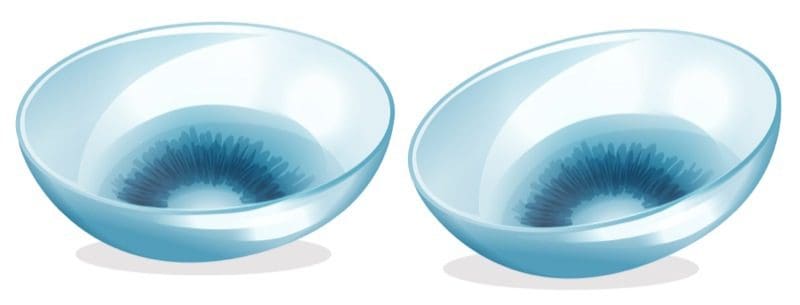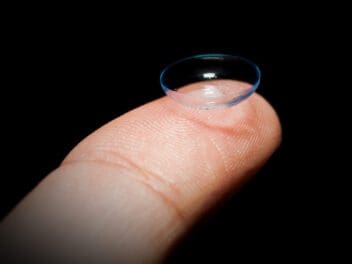Is It Actually Dangerous to Sleep With Contacts In?
Home / Understanding Contacts /
Last Updated:
Most contact lenses are designed to be worn during the day and then taken out at night. Some are meant to be disinfected, stored overnight, and replaced on a specific replacement schedule, while others are designed to be worn once and then disposed of after one-time use.
Table of Contents
Sleeping in daily disposable contacts, which are only meant to be worn during the day, can increase the odds for eye infections and corneal ulcers. It can also cause vision loss and even lead to blindness.
There are some contacts lenses that are FDA-approved for overnight use for one night or even up to a month of continuous use. Not everyone can tolerate this.
Contacts block oxygen from flowing freely to the eye. They can also trap dirt and debris underneath them. Both of these reasons make it potentially hazardous to sleep with contacts in.
Contacts designed for overnight use are gas permeable, but they still do not allow the full amount of oxygen through and can lead to potential problems. Falling asleep with your contacts in one time is probably not going to be a big deal, but doing it all the time can be dangerous.
Follow all instructions related to your specific type of contact and talk to your eye doctor about possible hazards.

Risks of Sleeping With Contacts

Your eyes can generally tolerate this for a period of time, but they will need a break — generally at night. While you are sleeping, your eyes can “breathe” normally when you take your contacts out and sleep without them.
Most forms of contacts are meant to be worn during the day only. You are meant to take them out and either clean and store them in specialized contact lens solution overnight or dispose of them and replace them with new ones the next day.
All contacts come with specific care instructions and an explicit replacement schedule. They will generally need to be replaced either daily, weekly, monthly, or quarterly. In the case of RGP contacts, they may only need to be replaced annually. Traditional contacts are not designed for multi-day or overnight use.
Wearing your contacts overnight can increase the risk for the following:
- Eye infections
- Corneal ulcers
- Hypoxia of the eye
- Inflammation
- Contact lens acute red eye (CLARE)
- Giant papillary conjunctivitis (GPC)
- Eye irritation
- Debris and dirt getting trapped underneath them
If they are not designed for this purpose, wearing your contacts overnight on a regular basis can lead to eye and vision problems and even potential blindness.
Extended-Wear Contacts and Overnight Use

The FDA approves some contacts for extended wear. These can be worn overnight for even as long as a month continuously. Not everyone’s eyes may tolerate this, however. The FDA recommends taking extended wear contacts out at least once a week for one day/night to let the eyes rest and recover.
Wearing your contacts overnight increases the odds for eye infections, as bacteria can get trapped under them. The longer you keep them in your eyes, especially when they are closed, the longer the bacteria can grow unimpeded.
Eye infections can range in severity from conjunctivitis (pink eye) to keratitis and fungal eye infections that can lead to vision problems and even potential vision loss.
Even if contacts are approved for overnight use, wearing them to sleep increases the odds for contact-related complications and eye problems.
Why Sleeping in Contacts Is a Bad Idea
Falling asleep in your contacts one time is not likely to lead to long-term damage. You may wake up with red and irritated eyes that are more dry than normal, and you may not be able to tolerate your contacts the next day, but taking them out and letting your eyes recover for a day or so will probably fix the issue.
The real problems come when you keep wearing your contacts to sleep on a regular basis. The Centers for Disease Control and Prevention (CDC) warns that sleeping with your contacts in makes you six to eight times more likely to suffer from a corneal infection. Infections in the eye can be uncomfortable, and they can also cause permanent vision loss.
Wearing your contacts overnight stresses the cornea and can lead to tears, scratches, irritation, and inflammation. It can also deprive your eyes of oxygen. When your eyes do not get enough oxygen, a buildup of blood vessels on the cornea can form, which can lead to corneal neovascularization.
This level of inflammation can actually change the shape of your cornea and make it so your contacts will not fit anymore. Sleeping with contacts in can potentially make it so you will be unable to wear contacts at all anymore.
In short, it can be dangerous to continuously sleep with contacts in. Always follow all instructions related to your specific type of contact lens and how long you can wear them.
You deserve clear vision. We can help.
With 135+ locations and over 2.5 million procedures performed, our board-certified eye surgeons deliver results you can trust.
Your journey to better vision starts here.
References
- Types of Contact Lenses. (January 2018). U.S. Food and Drug Administration.
- Extended Wear Contact Lenses. (September 2016). All About Vision.
- Corneal Infections Associated with Sleeping in Contact Lenses- Six Cases, United States, 2016-2018. (August 2018). Centers for Disease Control and Prevention (CDC).
- Sleeping With Your Contacts In: Is It Bad? (2019). National Sleep Foundation.
This content is for informational purposes only. It may have been reviewed by a licensed physician, but is not intended to serve as a substitute for professional medical advice. Always consult your healthcare provider with any health concerns. For more, read our Privacy Policy and Editorial Policy.
